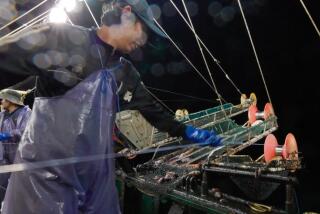Peru Fishermen Getting Dolphins, Market Catch
- Share via
CERRO AZUL, Peru — Most mornings fisherman Esteban Francia hauls in his nets and lets thousands of hake, cod and sharks spill onto the deck of his small boat.
But mixed among the piles of fish caught overnight Francia usually finds a special treat that will bring him a good price ashore--dolphins, which get tangled in his nets and drown. They make delicious eating, he said.
“I almost never find only one or two dolphins. Either there are none at all, or there’s a whole herd of them,” he said.
“Sometimes I find 10 or 15 dolphins in the nets. Where there are fish, there are dolphins, so they get caught in the nets along with the fish.”
While ecologists around the world bristle at dolphin killing, fishermen up and down Peru’s Pacific coast eagerly haul them in by the dozen and sell their salty, protein-packed meat at premium prices.
At upscale restaurants in Lima, the capital, Peruvians eat chunks of dolphin meat mixed with onions and avocado in a tangy appetizer known as muchame.
In Cerro Azul, a fishing village 80 miles south of Lima, residents like to cook dolphin meat in a stew and serve it with vinegar and spices.
Other towns have their own recipes, such as mixing it with shrimp or rice.
With dolphin meat growing popular as a gourmet novelty, scientists say at least one species, the dusky dolphin, is now seriously depleted.
Current catch rates far outstrip the speed at which it reproduces, and the dusky dolphin may soon become scarce along Peru’s coasts, the experts say.
The dusky dolphin moves close to shore and reproduces during the Southern Hemisphere winter--July, August and September--when fishermen catch them.
Pregnant dolphins and calves, some of them barely the size of a small dog, get tangled in the nets and are chopped into steaks along with full-grown males.
Bones and entrails of slaughtered dolphins litter the beach at Cerro Azul.
More to Read
Sign up for Essential California
The most important California stories and recommendations in your inbox every morning.
You may occasionally receive promotional content from the Los Angeles Times.













